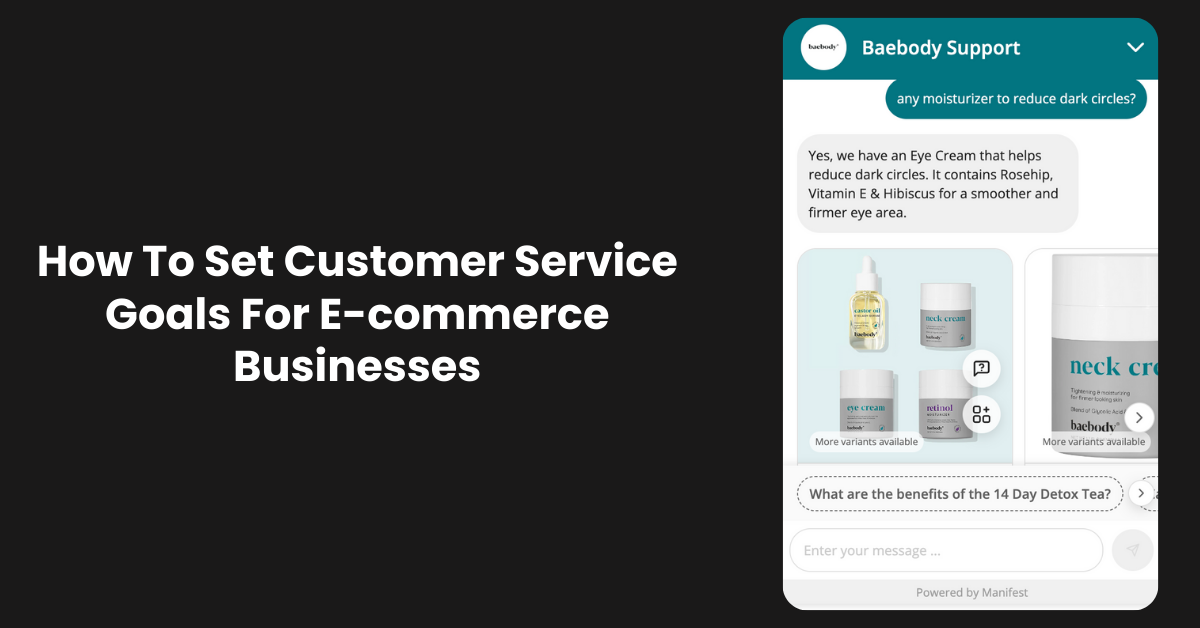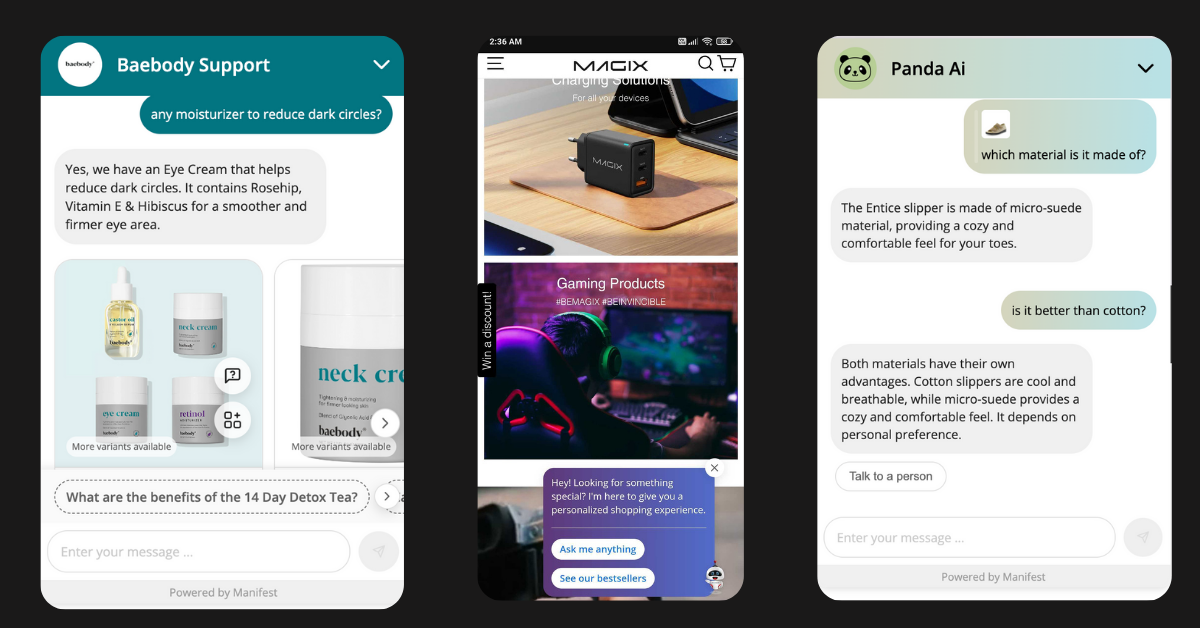How To Set Customer Service Goals For E-commerce Businesses

In the current digital era, where e-commerce is the norm, providing excellent customer service is now essential and cannot be overlooked. Setting realistic goals for customer service is essential for e-commerce companies looking to provide the ideal client experience. But how do you make your way through the complex maze of goals and KPIs to make sure your staff is providing outstanding customer service that fosters development and loyalty? Get your seat, business owners. This blog post delves deeply into the critical processes involved in establishing customer service objectives and customer service goals examples that can inspire your staff, thrill your clients, and significantly increase your online business. Prepare to give up guesswork and adopt data-driven tactics for a successful customer-focused company.
Why Setting Customer Services Goals Are Important For Online Businesses?
Here's why setting customer service goals is essential for online businesses:
Boosts Customer Satisfaction and Loyalty

Happy customers are loyal customers. By setting customer service goals around key metrics like resolution times, first-contact resolution rates, and customer satisfaction scores, you ensure your team is consistently striving to meet and exceed customer expectations. This fosters trust and positive relationships, leading to repeat business and positive word-of-mouth recommendations.
Enhances Brand Reputation

Word travels fast online, and positive customer experiences can quickly turn into online praise and glowing reviews. Conversely, negative experiences can spread like wildfire, damaging your brand reputation. Setting customer service goals around proactive communication, responsiveness, and personalization demonstrates your commitment to providing excellent service, building trust and strengthening your brand image.
Improves Efficiency and Agent Performance

Customer service goals for performance review provide a clear benchmark for measuring agent performance and identifying areas for improvement. By setting goals around factors like average handle time, call abandonment rates, and knowledge base utilization, you can pinpoint areas where your team can be more efficient and effective. This translates to faster resolution times, happier customers, and a more productive customer service team.
Drives Business Growth

Happy customers spend more. Studies show that loyal customers are more likely to make repeat purchases, spend more per transaction, and refer your business to others. By setting customer service goals that focus on customer retention and advocacy, you unlock the potential for increased revenue and sustainable growth.
Provides Measurable Results
Setting SMART goals (Specific, Measurable, Achievable, Relevant, and Time-bound) allows you to track your progress and measure the impact of your customer service efforts. This data-driven approach enables you to refine your strategies, allocate resources effectively, and continuously improve your customer service performance.
How To Set Customer Service Goals For Your Businesses?
In the age of instant gratification and online reviews, customer service team goals has become the cornerstone of any successful business. But simply aiming for "good" service won't cut it anymore. To truly stand out and thrive, you need a strategic approach, and that starts with setting clear, measurable, and impactful customer service goals.
Here's your guide to navigating the world of customer service goal-setting:
Define Your Customer Service Vision
Before diving into metrics, take a step back. What do you want your customer service to achieve? Do you aim for lightning-fast resolution times? Personalized interactions that build loyalty? Defining your vision will guide your customer service goals selection and ensure everything aligns towards a specific outcome.
Identify Key Customer Segments
Your customers aren't a monolith. Different segments may have different needs and expectations. Segment your customers based on factors like demographics, purchase behavior, or support channels used. This allows you to tailor customer service goals to specific needs and measure progress effectively.
Choose the Right Metrics
Don't get lost in a sea of data! Focus on key metrics that directly reflect your customer service goals & vision and segment-specific goals. Common metrics include:
Customer satisfaction (CSAT) scores: Measure customer happiness with your service.
Resolution times: Track how quickly you resolve customer issues.
First contact resolution rate: Gauge how often issues are resolved in the first interaction.
Net Promoter Score (NPS): Assess customer loyalty and willingness to recommend your business.
Customer effort score (CES): Understand the ease of getting their issue resolved.
Set SMART Goals
Remember the SMART customer service goals framework? Make your goals Specific, Measurable, Achievable, Relevant, and Time-bound. For example, instead of "Improve customer satisfaction," aim for "Increase CSAT score for tech support inquiries by 5% within Q3."
Prioritize and Balance Goals
Avoid overloading your team with too many customer service goals. Prioritize the most impactful ones and ensure they balance different aspects of customer service, like efficiency and personalization.
Align with Business Objectives
Customer service goals shouldn't exist in a vacuum. Ensure they complement and support your broader business objectives, like increasing revenue or customer retention.
Empower and Motivate Your Team
Customer service goals are not just numbers; they are tools for motivation. Involve your team in the goal-setting process and foster a culture of ownership. Celebrate successes and provide ongoing feedback to keep everyone engaged.
Track, Analyze, and Adapt
Regularly monitor progress towards your goals and analyze the data. Don't be afraid to adjust or adapt your goals based on what you learn. This ensures your strategy remains relevant and impactful.
10 Crucial Customer Service Goals In D2C Businesses
In the competitive landscape of D2C, where customer loyalty is king and trust is paramount, exceptional customer service is no longer a nice-to-have, it's a survival necessity. To truly stand out, D2C businesses need to set clear, measurable, and impactful customer service goals that go beyond just resolving issues. Here are 10 crucial customer service goals to focus on:
Foster Brand Advocacy
Net Promoter Score (NPS): Aim for a score above 70, indicating high customer loyalty and willingness to recommend your brand.
Brand sentiment analysis: Track online reviews and social media mentions to gauge how customers perceive your brand and customer service.
Customer engagement: Encourage active participation in brand communities and social media conversations.
Prioritize Personalization
Customer segmentation: Tailor communication and support based on individual needs and preferences.
Proactive outreach: Anticipate customer issues and offer solutions before they arise.
Product recommendations: Leverage customer data to suggest relevant products and enhance the shopping experience.
Speed Up Resolution Times
First contact resolution rate: Increase the percentage of issues resolved in the first interaction.
Average handle time: Reduce the average time it takes to resolve a customer issue.
Optimize communication channels: Streamline communication across different channels (phone, email, chat) for faster response times.
Build Trust and Transparency
Honesty and transparency: Be upfront about product information, shipping delays, and any other potential issues.
Easy access to support: Make it easy for customers to reach you through convenient channels and offer 24/7 support if possible.
Clear and concise communication: Avoid jargon and technical terms, ensure clear and easy-to-understand communication.
Empower and Motivate Agents
Agent satisfaction: Conduct regular surveys to gauge agent morale and identify areas for improvement.
Training and development: Invest in ongoing training programs to equip agents with the knowledge and skills to handle complex situations.
Performance recognition: Celebrate individual and team achievements to motivate and incentivize agents.
Utilize Technology and Data
Customer relationship management (CRM) systems: Leverage CRM tools to track interactions, manage customer data, and personalize the experience.
Feedback analysis tools: Analyze customer feedback to identify trends and areas for improvement.
Artificial intelligence (AI) and chatbots: Implement AI-powered chatbots like Manifest AI for faster responses and 24/7 availability.
Measure and Track Progress
Regularly monitor key metrics: Track progress towards your goals using relevant metrics and data.
Set achievable milestones: Break down large customer service goals into smaller, measurable milestones to maintain momentum.
Share results and celebrate successes: Keep your team informed and motivated by sharing progress reports and celebrating achievements.
Embrace Continuous Improvement
Analyze customer feedback: Use customer feedback to identify pain points and areas for improvement.
Benchmark against competitors: Stay ahead of the curve by learning from other successful D2C brands.
Be open to change: Adapt your customer service strategy based on new trends and customer needs.
Build a Customer-Centric Culture
Empower employees: Encourage employees to go the extra mile to provide exceptional service.
Focus on building relationships: Treat customers as individuals, not just transactions.
Go beyond resolving issues: Proactively address customer needs and exceed expectations.
Integrate Customer Service with Marketing
Align customer service messaging with brand values: Ensure a consistent and cohesive customer experience across all touchpoints.
Leverage customer service data for marketing insights: Use customer feedback and data to personalize marketing campaigns and improve targeting.
Turn customer service into a marketing tool: Share positive customer stories and testimonials to build trust and attract new customers.
Boosting Customer Service Goals with GPT-Powered AI Chatbot

Boosting customer service goals in the e-commerce can be significantly enhanced with Manifest AI, a GPT-powered AI chatbot. Here's how it works:
- Intelligent Interaction: Manifest AI engages customers in conversation, understanding their queries and needs using natural language processing. This makes communication more efficient and user-friendly.
- Personalized Product Recommendations: By analyzing customer queries, the AI can recommend products that best suit their needs, enhancing the shopping experience.
- Efficient Query Handling: The AI can swiftly answer frequently asked questions, reducing the workload on human customer service representatives.
- Enhanced User Engagement: By providing relevant answers and product suggestions, the AI keeps customers engaged, potentially leading to increased sales.
- Data-Driven Insights: The AI's interactions can provide valuable insights into customer preferences, helping to tailor the store's offerings and marketing strategies.
Conclusion
Recall that creating a successful customer-centric culture is more important than simply checking boxes when establishing customer service goals . Customer service can be turned from a cost center to a competitive advantage by embracing continuous improvement, empowering your team, and concentrating on the correct KPIs. Thus, start now, make those objectives, and observe how your e-commerce company grows with devoted clients and long-term prosperity.
How to set individual customer service goals?
Setting individual customer service goals involves tailoring objectives to enhance the service experience for each customer. Here are key steps to achieve this:
- Understand Customer Needs: Begin by understanding the unique requirements and preferences of your customers.
- Set Clear Objectives: Define specific goals that focus on improving areas like response time, customer satisfaction, or issue resolution efficiency.
- Measure Performance: Implement metrics to assess progress towards these goals, ensuring they are realistic and achievable.
- Feedback and Adaptation: Regularly review performance and customer feedback to refine goals and strategies for better service delivery.

.png)
